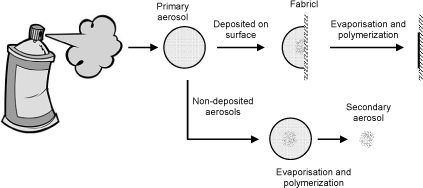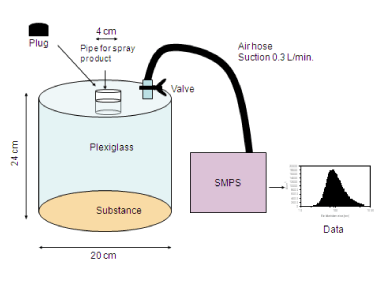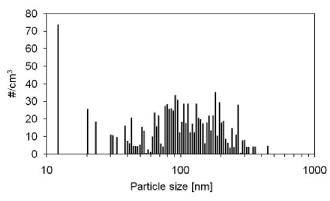Survey and Health Assessment of Products for Interior Car Care
7 Nano products
It is well-known that aerosols under 2.5 µm form a special health hazardous risk during inhalation. In addition, recent years have focused on the health related risks from airborne nano particles (ultrafine particles)[5] as these particles to a higher degree than larger particles penetrate into the alveolar and tracheobronchial respiratory passages.
Nano aerosols are often created when using spray products. Figure 7.1 illustrates the principles of the creation of aerosols when using spray products. A pump or propellant-based spray mechanism creates primary aerosols in a liquid state consisting of solvent and active substances for spray waterproofing. When the solvent has evaporated, the non-deposited aerosols are transformed to secondary solid-state aerosols consisting of totally or partly polymerized waterproofing spray substances.

Figure 7.1 Sketch of the creation of fine and ultrafine (nano) particles/aerosols after evaporation of solvent from the fraction of the primary aerosols that are not deposited on the fabric surface.
According to the manufacturers, a number of products for interior car care are based on nano technology. In the project, measurements were carried out of the particle size distribution of aerosols in spray products that are marketed as being based on nano technology (product no. 22, 23, 24 and 41). The distributors of product no. 22, 23 and 24 cannot say what they precisely mean by the products being based on nano technology; however, the manufacturers of all four products inform that they contain nano particles. The chemical composition of the nano particles is not stated and it does not appear if solid-state particles are in question. It is stated that product no. 41 is based on sun-gel-chemistry and therefore it is expected to contain silane compounds, as commercial sun-gel-based surface treatment products to be used at room temperature normally are based on silane chemistry[6]. The composition of the listed nano particles was not informed.
That means that primary, secondary or possibly added nano particles might be in question. It is also possible that merely products resulting in the creation of a film on the fabric surface with nano size thickness are in question.
Currently, no standardised methods exist for measuring the liberation of nano aerosols from spray products. Therefore, this project has used an analysis method developed in the analysis project of the Danish Environmental Protection Agency concerning spray products for fabric waterproofing (described in chapter 7.1).
7.1 Experimental course for particle measurements
The 4 products were screened for liberation of particles of up to 1 µm in aerodynamic diameter during use on a piece of fabric, in this case undyed cotton. Exposure took place in a purpose-built experimental chamber. Undyed cotton with a pore size of 200-300 µm was covered over a purpose-built, half-closed experimental chamber with a volume of 7.5 litres (Figure 7.2) so the distance from the product to the fabric was 24 cm.

Figure 7.2 Schematic drawing of the experimental setup.
Aerosols created by the spray products were measured behind the product, corresponding to the ordinary application situation where the user directs the spray away from the body. That means that spraying did not take place directly into the measuring device, but measuring took place on aerosols liberated into the air when the products were used. It is estimated that the consumer will not by mistake be able to spray towards the face as the hand of the consumer will protect the face if the spray can is turned the wrong way. The consumer is not expected to be exposed to a larger exposure of aerosols if there is an accident. Damage to the can will probably result in greater exposure in relation to solvents but not in the creation of additional aerosols.
Particle size distribution of the aerosols was measured with a Scanning Mobility Particle Sizer (TSI SMPS 3934 equipped with Differential Mobility Analyzer (DMA model 3081) and ultra fine Condensation Particle Counter (CPC model 3776)). Aerosols were sucked into the device and passed a radioactive source by means of which the aerosols obtained a known charge distribution. The aerosols were then led in a laminar air flow through an electric field that separates particles according to size.
The particles were counted with a condensation particle counter. Depending on the configuration the instrument can measure particles in the interval of 2-1000 nm. In this project, measuring took place in the interval of 6-650 nm. The instrument counts all aerosols irrespective of composition and form (solid or liquid). As the content of nano particles in the products before use was not determined in this project, it cannot be decided to which extent the aerosols contain nano particles that were present in the liquid phase.
Figure 7.3 gives a schematic presentation of the experimental course. After 10 seconds of waterproofing, the experimental setup was closed with a plug. After 60 seconds, aerosols were measured in the order of magnitude of 20-650 nm. That measurement took 60 seconds. Then another 5 minutes passed and the measurement was repeated. The objective of the follow-up analysis was to investigate if the size distribution changed in the period immediately after use due to solvent evaporation. Then the aerosol flow was increased from 0.3 litre/minute to 1.5 litre/minute in order to measure particles down to 6 nm.

Figure 7.3 Schematic presentation of the experimental course.
Before each measurement, the background level of particles was measured and it demonstrated that the number of background particles varied from 500-4000 particles/cm³ per minute (a typical background measurement is shown in Figure 7.4) which it a normal level for interior air.

Figure 7.4 Particle size distribution (concentration of particles (number per. cm³) in each of the 100 logarithmically distributed size intervals) of normal interior air measured with SMPS.
7.2 Results of particle measurements
The measured aerosol concentrations have been collected in Table 7.1Table 7.1. The particle size distribution appears from Figure 7.5. The largest uncertainty on the measurement results is found in the reproducibility of the amount and in the way the waterproofing liquid leaves the products during 10 seconds of continuous use. The uncertainty on the total amount of liberated particles is ±40%. The uncertainty on the mean value of the particle diameter is ± 20%.
The measurements are based on 10 seconds of use in an experimental chamber of 7.5 litres. If the products are used for a longer period of time and over a larger volume, the particle concentrations are expected to change proportionally; if secondary aerosols are in question the particle size distribution is expected to be unchanged.
Click here to see: Table 7.1 Aerosol concentrations
As appears from Table 7.1Table 7.1, aerosols are not created at a level above normal interior air when using product no. 41. In connection with product 23 and 24 enough aerosols are created making them measurable in relation to an ordinary background level. For these products, the mean particle size of the measured particles is >100 nm (cf.Table 7.1Table 7.1) and the particle concentrations are lower compared with most propellant-based spray products for fabric waterproofing[7]. Product no. 22 creates ultra fine (<100 nm) aerosols at a level that is more than 100 times above the normal indoor level. The reason for the high level can be the content of nano particles in the product; however, levels of the same size have been observed for spray products that are not marketed as ”nano”76. The high level of aerosols observed for product no. 22 might be due to the specific construction of the spraying device of the product (propellant pressure and valve design).
The chemical composition of the measured aerosols has not been determined. As with the aerosol analyses carried out in the project concerning spray products for fabric waterproofing4 it can by comparing the particle sizes (Table 7.1Table 7.1) after 1 and 7 minutes, respectively, be seen that the solvents evaporate very quickly (< 1 minute). The measured aerosols are therefore expected to consist of completely or partly polymerised waterproofing agent and nano particles that were present in the products (solid state, secondary aerosols, cf. Figure 7.1).
A consumer of product no. 22 (foam spray with propellant) is therefore exposed to ultra fine solid state aerosols (< 100 nm) at a level two sizes above normal indoor air. It is a well-known fact that inhalation of ultra fine aerosols can have negative health effects[8], but in most cases individual tests have to be carried out with each chemical substance in nano form in order to express an opinion about the health effects of nono exposure. Such an evaluation is not comprised by this project.
However, it is clear that caution has to be exercised in general when using spray products. The experiment with this product shows that just as with other spray products for fabric waterproofing76 airborne particles in nano form appear in connection with normal use of the product.
[5] Refer to e.g. ISO/TC 146/SC 2 N 399
[6] Sun-gel group, Centre of Materials Testing, Danish Technological Institute
[7] Cf. Aerosol measurements carried out in the analysis project of the Danish Environmental Protection Agency about sprays for fabric waterproofing.
[8] Refer to e.g. ISO/TC 146/SC 2 N 399
Version 1.0 December 2010, © Danish Environmental Protection Agency